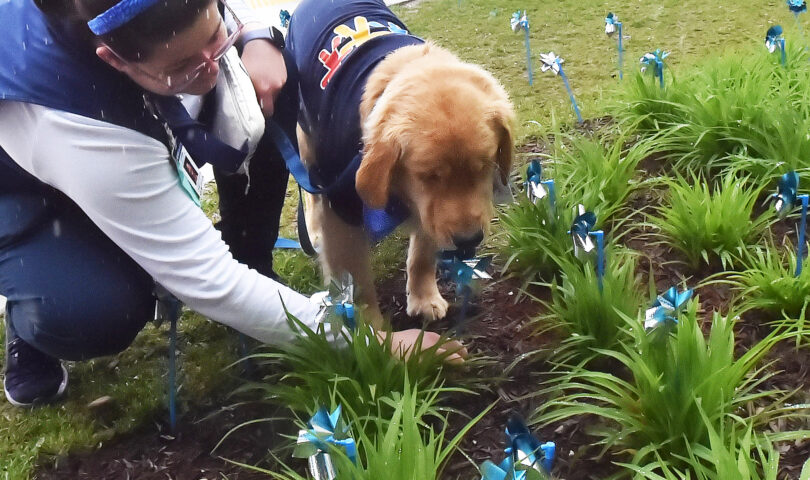April is National Child Abuse Prevention Month – a time when child advocacy groups nationwide bring attention to the importance of putting children and families first.
“Here at WVU Medicine Children’s we wanted to recognize that, and we did that by having a pinwheel event,” said Dr. Amy Gavril, division chief of child safety and advocacy in the department of pediatrics.
The Pinwheels for Prevention campaign was first introduced in 2008 by the Prevent Child Abuse America organization and since then pinwheels – particularly in blue and silver and blue – have become the national symbol for child abuse prevention.
“The pinwheels symbolize playfulness, joy and childhood,” Dr. Jeffrey Lancaster, associate chief medical officer at WVU Medicine Children’s, told the small crowd that gathered outside the hospital doors for the pinwheel event at noon Thursday.
Pinwheels have come to serve as a physical reminder of a great childhood and also represent efforts to focus upon community activities and public policies that prioritize child abuse prevention.
“We are trying to do as much as possible to help West Virginia children and this is just a wonderful event to kind of celebrate all that,” Gavril said.
Following some short remarks from the doctors, staff members “planted” several dozen pinwheels in the Reflection Garden near the hospital entrance as well as some along the sidewalks by Milan Puskar Stadium.
“Today we are planting pinwheels to symbolize our efforts in preventing child abuse in West Virginia and all the surrounding communities,” Lancaster said. “As you all know, child abuse in West Virginia is still a major cause of morbidity and mortality in our patients, which is an absolutely heartbreaking thing for the families, for the communities and for all the folks who work here in this hospital.”
Gavril said she hopes that when people see the pinwheels it will spark interest and spark conversation about child abuse and increase acknowledgment that child maltreatment occurs.
“Child abuse is one of those topics that make a lot of people uncomfortable,” she said. “Unfortunately, a very common response to feeling uncomfortable about a situation is to kind of look the other way or ignore it and pretend it never happened.
“But with child abuse we really need to start a conversation and start discussing and educating about different forms of child maltreatment not only within medicine, but within the health community,” she said. “Because it really is a community effort to try to identify it so we can help child victims.”
While most people are aware that child abuse happens, Gavril said she believes a lot of people assume it happens somewhere else. But the fact of the matter is that child maltreatment affects all communities, all states, all countries and it is more common, unfortunately, than we tend to believe.
“Like every state we do have child abuse here,” she said. “Our child abuse rates are relatively high compared to the national average – we are third highest in the country just below Maine and Alaska. So, we do have a significant child maltreatment problem in West Virginia.”
According to Lancaster, in continued recognition of Child Abuse Prevention month, WVU Medicine Children’s will feature various educational activities for families and staff led by Gavril and their pediatric trauma service team.
The work doesn’t last for just a month, however. Gavril said over the past year they have been doing a lot to support West Virginia children and addressing issues of child maltreatment.
“We have an awesome pediatric forensic nurse examiner team. It’s actually the largest in the state of West Virginia,” she boasted.
In the past few months, they have also implemented a few programs including a best practice alert system in electronic medical records and a nurse child abuse screening tool.
“The purpose of those is to help medical providers to think about the possibility of child maltreatment in some of the children that present to us. If you don’t think about it, you can’t address it,” Gavril said.
Despite common misconceptions, child abusers do not have a certain look. In fact, she said the vast majority of child abusers are not the monsters they are made out to be.
“The vast majority are loving parents who just went through a set of circumstances, had a momentary lapse of judgement, but they love their children,” she explained.
The point of addressing child abuse is not only to treat the child if they have medical problems, but also to attempt to get the whole family as a unit.
Another program that has recently gotten off the ground, the Division of Child Safety and Advocacy, will help with community outreach and education. The new division’s purpose is to not only address child maltreatment issues in the children seen at WVU facilities, but also to educate about child abuse and to do advocacy outreach to our community partners.
Gavril said they are currently working with three area child advocacy centers that cover five counties and are also medical representatives on 13 multi-disciplinary teams that address child abuse in their communities.
On April 1, Governor Jim Justice officially proclaimed April as Family Strengthening and Child Abuse Prevention Month for West Virginia.
To show support for children and families and to help build momentum for Family Strengthening and Child Abuse Prevention Month, West Virginians are encouraged to participate in “Wear Blue Day” on Friday, April 5. The color blue and silver and blue pinwheels are the recognized symbols for child abuse prevention.




